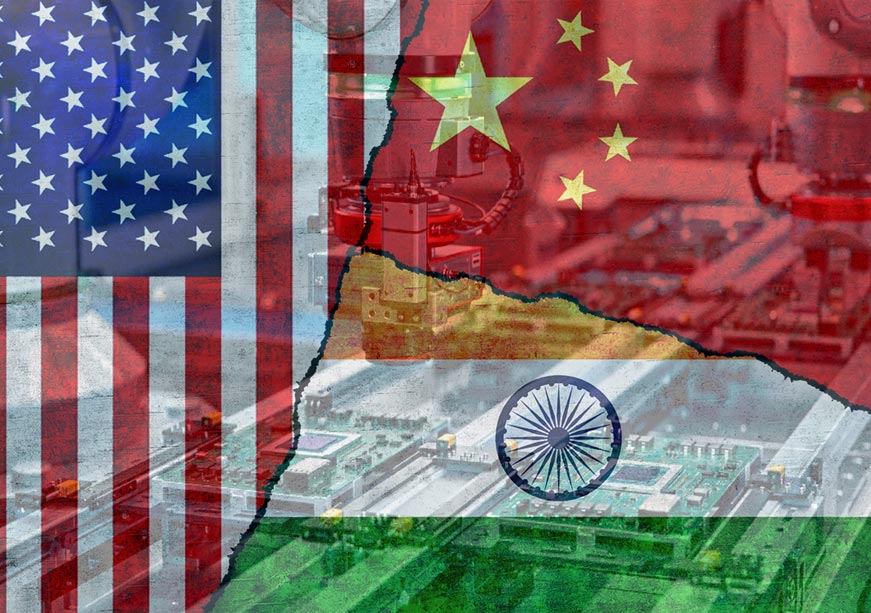-
CENTRES
Progammes & Centres
Location
Vance calls for India to anchor the US manufacturing pivot, as Beijing’s concerns over growing Indo-US ties heighten

Image Source: Getty
While visiting India in April 2025, the United States (US) Vice-President J. D. Vance pitched for better bilateral ties and a greater stake for New Delhi in America’s manufacturing economy. The visit has given a new fillip to bilateral trade negotiations and defence cooperation. Vance also proposed the co-production of munitions, the joint-autonomous systems industry alliance, and the development of maritime systems. Vance referred to the intention of ‘hostile powers’ to dominate the Indo-Pacific in a reference to China.
Amid US President Donald Trump’s tariff onslaught against China, the Commerce Minister Piyush Goyal has put the onus on Beijing for distorted labour models, hidden subsidies, and unfair trade practices. Goyal also contrasted China’s Belt and Road Initiative (BRI) with the India-Middle East Economic Corridor (IMEC), stating that the latter does not violate the sovereignty of nations and territorial integrity. The IMEC ablueprint envisages a network of road, rail, and maritime links from India, Saudi Arabia, Europe, and beyond, connecting Asia to the West. New Delhi’s stand on China’s BRI has been consistently in opposition, considering the China-Pakistan Economic Corridor (CPEC) runs through Pakistan-Occupied Kashmir (POK), which India claims belongs to an undivided Jammu and Kashmir.
The IMEC ablueprint envisages a network of road, rail, and maritime links from India, Saudi Arabia, Europe, and beyond, connecting Asia to the West.
Beijing sees these assertions as a convergence of Washington and New Delhi’s interests. This has spurred Chinese commentators to assess the evolving nature of India-US relations under Trump 2.0 and Modi 3.0 administrations.
Chinese commentators highlight Foreign Minister S. Jaishankar’s front-row seating at Trump’s inauguration and Prime Minister (PM) Narendra Modi’s Washington visit in February 2025 as evidence of brewing bonhomie. Nonetheless, they also note the ‘irritants’ such as Trump calling out India over high tariffs shortly. Vance is derisively referred to as ‘India’s son-in-law’. Mandarin-language writing claims that America’s goodwill towards India is primarily on account of getting inexpensive labour, its large consumer market, and its utility in containing China.
The aforementioned Chinese commentaries frame soft power as the basis of the US-India friendship. They propound that this soft power rests on the appeal of— immigration, technology jobs, the success of Indian-Americans, the dominance of the English language, Western funding of Indian think-tanks, US investment in Indian media outlets, and India-China tensions. However, there is a view that this soft power has limitations, given the issue of immigration that has become politically contentious in Washington. There is a foreboding that the soft-power quotient may not last in the face of the US tightening its immigration policy, and Trump’s rightwing constituency demonising immigrants from India.
India has been trying to develop manufacturing capabilities lately, but China links it to Trump’s tariff war against Beijing during his first term.
China perceives a sense of schadenfreude in New Delhi in the contretemps between Beijing and Washington. India has been trying to develop manufacturing capabilities lately, but China links it to Trump’s tariff war against Beijing during his first term. Its strategists feel that India was keen to benefit from this rupture in Sino-American ties and tried to revitalise the ‘Make-in-India’ campaign to improve manufacturing potential. According to the evidence, Chinese writings point to media reports that the Indian government had decided to earmark land parcels twice the size of Luxembourg in different states to house industrial units. This initiative was prompted by corporate houses voicing concerns about the protracted nature of land acquisition. But Beijing saw ulterior designs in New Delhi's wooing of large multinational companies with offers of business-friendly policies.
During the COVID-19 pandemic, China shut down factories to stop the contagion, which resulted in shortages and price-gouging. In turn, India launched the ‘Aatma-Nirbhar’ campaign, which Beijing interpreted as a move to shift industrial supply chains away from it. Chinese writing says that India saw this period and the opportunities it offered as comparable to China’s industrialisation efforts between the 1980s and 1990s. Cut to the current tariff war under Trump 2.0, Chinese commentators say that India again sees this as a ‘once-in-a-lifetime’ opportunity to relocate international production and supply chains and pursue industrialisation. As a result of this sustained effort by New Delhi, China evaluates that India’s industrial potential shows the characteristics of ‘diǎn zhuàng tūpò’ [点状突破] or ‘point-like breakthroughs’, essentially implying progress in foundational manufacturing of toys and smartphones. Trump singling out China paves the way for relatively lower levies on India, and there is a growing belief that India will leverage this situation to its advantage.
China perceives a sense of schadenfreude in New Delhi in the contretemps between Beijing and Washington. India has been trying to develop manufacturing capabilities lately, but China links it to Trump’s tariff war against Beijing during his first term.
In 2024, investment proposals from certain Chinese companies in electronics manufacturing received approval. In some cases, investment proposals involving Indian companies partnered with Chinese firms holding minority stakes, Taiwanese firms listed in Hong Kong, or Taipei-based companies backed by Hong Kong investors received clearances. The government panel scrutinising the joint ventures had set conditionalities on value addition. Another rider reported that Chinese nationals would be debarred from holding key positions in joint-venture companies, or the foreign company cleared to operate in India. Thus, the approach of joint ventures has become a key economic security feature. Beijing commentators fear Chinese companies will be ‘strong-armed’ to enter joint ventures with lower equity stakes with Indian firms, enabling the latter to acquire technology with little effort.
Chinese writers also point to Beijing and New Delhi’s divergent development paths. They see fundamental strength in China concentrating on mastering core technologies, cultivating local leading enterprises like Huawei, BYD, and ByteDance, and cutting through the US technological blockade by developing domestic intellectual property. India’s supposed obsession with the ‘prosperity of Silicon Valley outsourcing’ is a flaw, say Chinese strategists, and could lead to the nation coming under the US technological hegemony.
Beijing’s strategists are wary of the growing India-US ties in light of its tariff war with Washington. China sees India’s approach as keen to benefit from the ‘current chaos’ and ‘collapse of global order’ by sealing trade deals with the US and developed economies. There is a feeling that the trade deals will come at the expense of China’s interests, and to promote manufacturing initiatives like ‘Make-in-India’ to provide a fillip to India’s growth story. It sees New Delhi as keen to profit from the flux in the global order to achieve its objective of becoming a great power.
India’s supposed obsession with the ‘prosperity of Silicon Valley outsourcing’ is a flaw, say Chinese strategists, and could lead to the nation coming under the US technological hegemony.
Beijing perceives that the nature of the US-India cooperation is aimed at China and seeks to disadvantage Russia. China’s strategists argue that Washington’s defence strategy is to enhance New Delhi’s military capabilities by selling the US armaments and stymying cooperation with Moscow. They also see Trump’s intent to sell crude oil and gas to prise India apart from Moscow, warning India must remain vigilant and not become ‘Asia’s Ukraine’.
In conclusion, China’s economic woes, compounded by Trump’s tariff war, and the growing India-US relationship have heightened Beijing’s insecurity. Chinese strategists believe that India’s rise will come at China’s expense. The question that now remains is how this sentiment can impact the nascent India-China normalisation, given that there is a perception among China’s strategic community that New Delhi could be incentivised to join other countries to balance China. Thus, China could prefer to keep the border issue alive as a leverage one way or another.
Kalpit A. Mankikar is a Fellow with the Strategic Studies programme at the Observer Research Foundation.
The views expressed above belong to the author(s). ORF research and analyses now available on Telegram! Click here to access our curated content — blogs, longforms and interviews.

Kalpit A Mankikar is a Fellow with Strategic Studies programme and is based out of ORFs Delhi centre. His research focusses on China specifically looking ...
Read More +